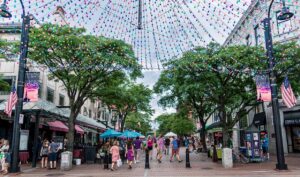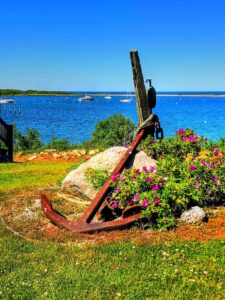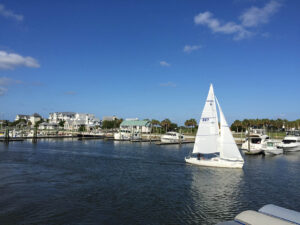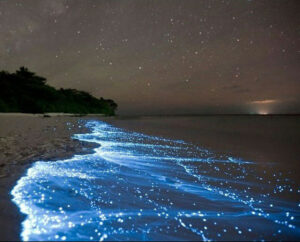Imagine entering a hotel lobby with such breathtaking design that presidents, celebrities and royalty gasped in awe. Picture a place so lively that Prohibition couldn’t stem the flow of champagne into delicate crystal glasses or silence jazz tunes that made appers’ toes start tapping.Then envision all this splendor set along sugar-white sandy beaches, turquoise waters and plush gardens.
These vivid images, peppered with intriguing tales, serve as a backdrop to luxurious historic hotels built during Florida’s Gilded Age where these grande dames of resorts reached a heyday in the early 1900s. Over time, some suffered from neglect but were lovingly restored to meet the needs of today’s discerning traveler and give a glimpse into a time of opulence and ambitious dreams.
THE MAN BEHIND THE VELVET CURTAINS
When visiting tropical resorts on Florida’s Atlantic coast, it’s hard to believe that a Cleveland oil tycoon was the mastermind behind their initial development. Henry Flagler, who helped John D. Rockefeller found Standard Oil, came to St. Augustine in 1880 seeking a hospitable climate for his ailing wife. Flagler became enamored with the area’s pristine beaches but was dismayed by lodging and transportation options.
Seeing potential among the palm trees, this visionary planned to create a “new American Riviera” by turning shing villages into world-class resorts and erecting a train system that would run all the way down to Key West. Mile after mile down the Atlantic coastline, Flagler laid tracks for the Florida East Coast Railroad and built or bought hotels along the way. In some towns he established schools, churches and hospitals that sparked local business growth. Key West, the last stop on Flagler’s line, was connected to the mainland by 1912.
In 1883, Flagler made St. Augustine his new home and the location for his first luxury hotel, Casa Monica. Built in 1888, the architectural gem was designed in Moorish Revival style and is famous for intricate balconies, Spanish tapestries and a stunning red roof. The owner ran into nancial trouble, so Flagler bought it and tacked on the new name, Cordova. When the stock market collapsed, Flagler abandoned the hotel and closed its doors in 1932. The structure sat vacant until 1962 when St. Johns County purchased it for use as a courthouse. At one point, the lobby housed police dogs trained to combat civil rights protesters. Fortunately in 1999, an Orlando developer got his hands on the property and restored Casa Monica to her former grandeur.
Flagler next set his sites on the barrier island of Palm Beach. On a 140-acre oceanfront property facing the Atlantic, he constructed a magni cent resort called The Breakers in 1896. Decked out in Renaissance Revival style with Italian art on the ceilings and a 200-foot long main lobby, this hotel attracted wealthy industrialists and socialites such as Vanderbilt, Rockefeller, Carnegie, American presidents and foreign royalty. Fires damaged the building in 1903 and 1925, but each renovation was more opulent than the next. It stands today as a monument to grand and gracious living.
Flagler continued to build hotels until his death in 1913, then others latched on to his dream of cultivating Florida’s coastline. The Roaring Twenties’ prosperity brought a uent visitors to glamorous new resorts along Flagler’s train trail. Movie stars, sports heroes, tycoons and politicians sipped iced cocktails on palm-lined verandas, and developers built Gatsby- style mansions to meet the rich and famous’ ravenous desire for lavish lodging.
One of the most extravagant resorts, The Biltmore in Miami, opened in 1926 to great fanfare. Exquisite frescos on vaulted ceilings, marble columns and mahogany furniture catered to America’s most noteworthy from Ginger Rogers and Bing Crosby to Franklin Roosevelt and Al Capone. The 400-room hotel was surrounded by posh gardens, a golf course, polo eld and a 23,000 square foot swimming pool that hosted bathing beauties, synchronized swimmers and alligator wrestlers.
Delray Beach residents marveled at the vibrant splendor of Mediterranean architecture when Colony Hotel & Cabana Club premiered in 1926. Its twin domed towers mirror the colors of the red and yellow awnings hung above arched windows. The original manual elevator is run by a uniformed operator, and sun shines through wide skylights on vintage wicker furniture, exotic orchids and tropical trees in the lobby.
Flagler only lived one year after his Overseas Railroad connected Key West to Florida’s mainland in 1912. He never saw his dream hotel open in 1920, but architects insisted the resort, Casa Marina, pay tribute to his achievements. To this day, Flagler’s portrait hangs in the elegant lobby anked by arched French doors and dark mahogany pillars. The U.S. Navy bought the property in 1942 for officers’ quarters during World War II. After decades of decline, the luxury hotel was fully restored in 2008. Today with chilled drinks in hand, guests gather at 6 acres of oceanfront beach to witness rosy Key West sunsets.
FROM FISHING CAMPS TO FASHIONABLE RESORTS
Florida’s West Coast didn’t have a billionaire oil baron to invest in historic hotels. Instead, the state’s quieter side experienced more subtle growth by wealth generated from bustling ports, exceptional seafood, abundant natural resources and agriculture. Stunning beaches, pristine waters and world-class fishing have attracted adventurous travelers to its shores for centuries. Staying at vintage resorts in this enchanting region gives visitors a taste of Old Florida’s grace and tranquility.
Up north on Florida’s panhandle in Apalachicola, Gibson Inn has epitomized Southern charm since 1907. Built during the Steamboat Era out of native pine and black cyprus wood, this bayside beauty was acclaimed as the only first-class hotel between Pensacola and Jacksonville heated entirely by steam. During World War II, it was used as Army officers’ quarters and then forsaken for years. Recent renovations restored its high ceilings, antique furniture and wrap-around porches with rocking chairs.
Overlooking Tampa Bay stands a spectacular model of Mediterranean Revival architecture, known as The Vinoy. Its distinctive rose-colored walls have drawn in notables such as Babe Ruth, Herbert Hoover and Jimmy Stewart since its launch in 1925. Like many resorts, it was seized by the Army and used as a training facility for military cooks and bakers. Some claim a ghostly gentleman strolls the grounds in old-fashioned formal attire. Perhaps he wants to derive a little paranormal pleasure from the luxurious estate, marina, golf course and spa.
Tarpon Lodge has had almost as many lives as a curious cat. Located at a secluded 32-acre estate on an island west of Fort Myers, this lovely hotel began in 1926 as a fishing lodge amid untouched natural beauty and crystal clear waters. Renamed Pine-Aire Lodge from 1945 to 1968, it became a favorite rural retreat for both business and labor leaders. Owned by American Bible College for over a decade, it became a learning center for the clergy. In 1980, Medical Management Institute bought and renovated the hotel to serve as an alcohol and drug rehab center, ironically on top of a wine cellar that was installed under the lobby during Prohibition. Today it’s held in family hands and offers a serene getaway from the mayhem of modern life.
On a picturesque seaside property between Pine Island Sound and theGulf of Mexico stands Tween Waters Inn. No surprise how it got its name, but the splendor of this hotel can be astonishing. Built in 1931 from a string of shing cottages where the likes of Anne Morrow Lindbergh and Teddy Roosevelt signed the guest book, its rustic ambience is alluring. The long stretch of white-sand beach presents an idyllic playground for sun worshipers and seashell collectors.





